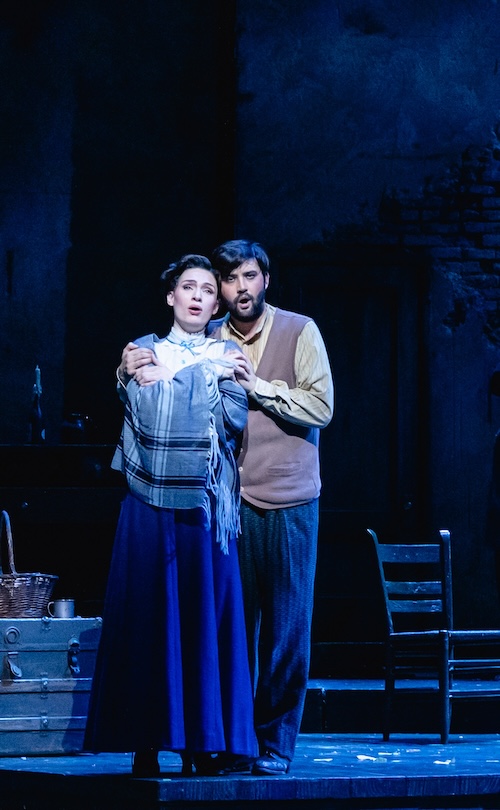Talented cast of debut singers sparks Dallas Opera’s delightful “Bohème”

Friday’s performance of La bohème marked the Dallas Opera’s eleventh production of Puccini’s story of artists living on the margins in nineteenth-century Paris. Director Tomer Zvulun’s traditional staging couched the audience favorite in comfortable and familiar environs that showcased the excellent performances by all of the young cast, most new to the Dallas Opera stage.
The principals were all outstanding. Soprano Sylvia D’Eramo, making her Dallas Opera debut as Mimi, had the strongest voice of the evening. Previously having sung the role of Musetta at the Metropolitan Opera, D’Eramo perfectly captured Mimi’s delicate character, particularly in her duets with Bekhzod Davronov’s Rodolfo in Acts 1 and 3.
Davronov, in turn, was captivating as Rodolofo. Winner of the second prize at Operalia 2021 and appearing as Alfredo during the Dallas Opera’s recent production of La traviata, Davronov’s rich tenor shone alongside D’Eramo with his rendition of “Che gelida manina” as well as Rodolfo’s despair over Mimi’s fate in the final act.
Emily Pogorelc’s beguiling portrayal of the free-spirited Musetta in her Dallas Opera debut provided a fitting contrast to D’Eramo’s Mimi. Pogorelc’s turn at Musetta’s signature number in Act II, “Quando me’n vo,” perfectly captured the vivaciousness of her character.
Baritone Takaoki Onishi’s depiction of Marcello made for a worthy foil for Pogorelc’s Musetta. Onishi vehemently traded verbal insults with Pogorelc in Act III while Onishi also revealed Marcello’s compassionate side in his sensitive performance in his respective duets with Mimi and Rodolfo.
William Guanbo Su and Efraín Solís as Colline and Schaunard rounded out Rodolfo’s companions sharing his Parisian garret, demonstrating the camaraderie among the destitute artists with their easy banter and collective singing. Their well-established amity made Guanbo Su’s farewell to his character’s overcoat, especially poignant.
Julien Robbins provided impeccable comic relief a the rent-seeking landlord, Benoít, and Musetta’s wealthy paramour, Alcindoro.
The representation of Paris’s Latin Quarter in Act II is a centerpiece of Puccini’s work, and the Dallas Opera’s realization did not disappoint. Members of both the Dallas Opera Chorus and the Greater Dallas Choral Society for Children and Youth together became a myriad of Parisians from all walks of life; street vendors, children, families, social elites, vagrants, and others were all engaged in the bustling activity of street life in front of the storefronts making up the impressive set, with the select clientele and staff of the Café Momus assembled at stage left.
Despite issues with balance at the beginning of the performance that were quickly resolved, the orchestra under Emmanuel Villaume deftly complemented the actions and sentiments emanating from the stage.
Although nominally set in 1830s Paris, the visual style and costumes of the production evoked a later Paris, perhaps of the 1870s or 1880s. The three environments called for in the opera – Rodolfo’s garret, the Latin Quarter, and the Barrière d’Enfer – were created by mounting textured panels onto a skeletal metal frame toward the rear of the stage. Surfaces of the panels simulated brick or masonry that could serve as either interior or exterior walls depending on the act being performed.
Projected images of the Parisian skyline behind the set further enhanced the atmosphere of the city. At one point in Act III, falling snow was simulated by additional projections both behind the set and onto a transparent screen at the front of the stage.
Subtly colored lighting complemented the physical settings and overall moods of the environments. The costume designs were based on those of Peter J. Hall, the long-time costume designer for the Dallas Opera who produced his first designs for La bohème for the company’s second production of the opera in 1966.
La bohème runs through Sunday, March 9. dallasopera.org